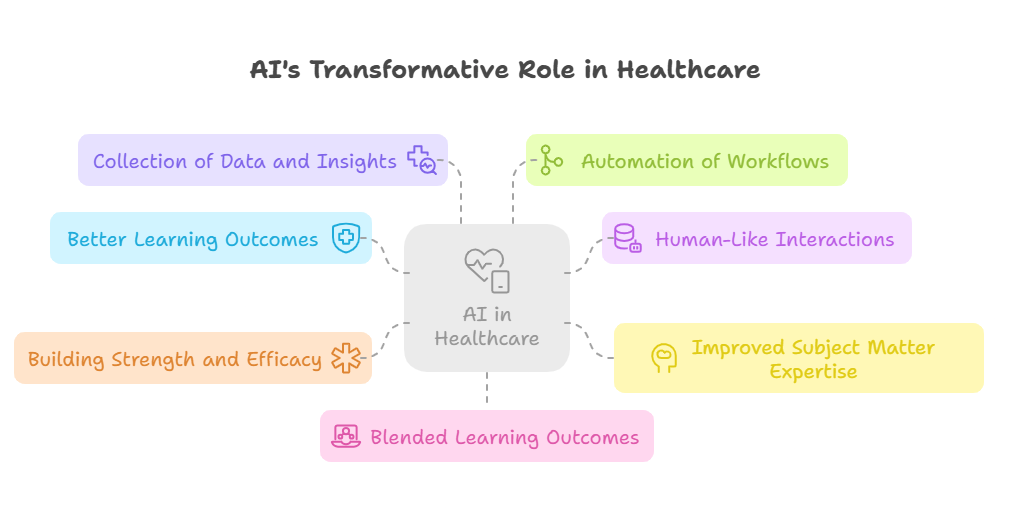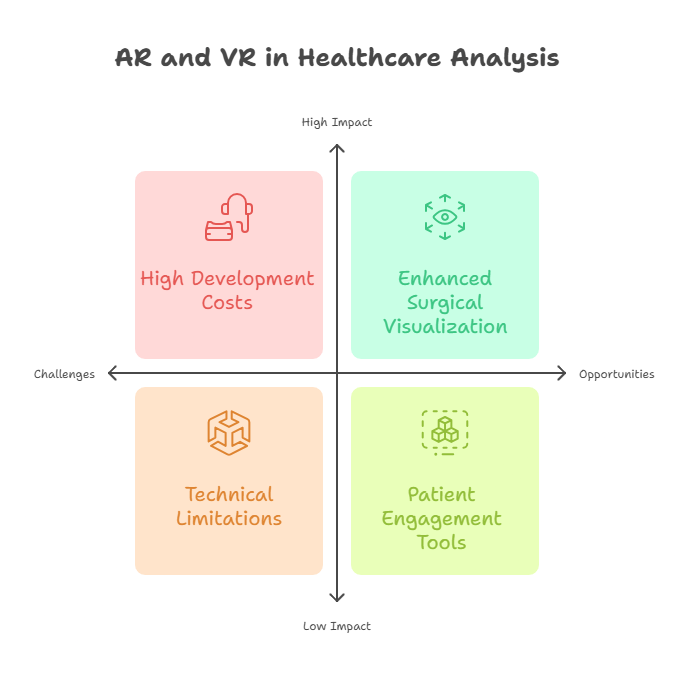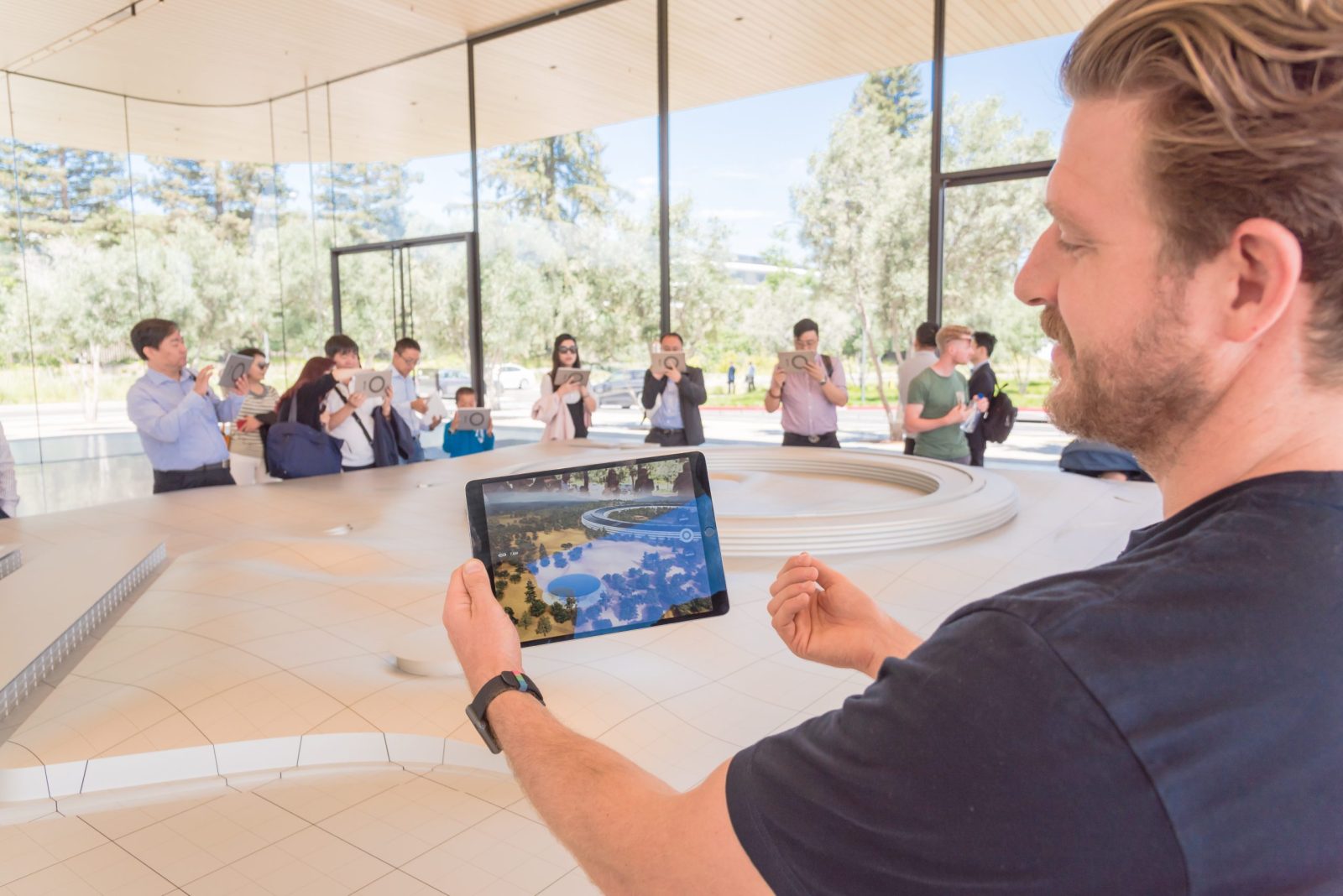
Training the Doctors of Tomorrow with AI and Immersive Tech
Summary
This blog explores how AI in healthcare is revolutionizing medical training and patient care by integrating AI, AR, and VR technologies to enhance learning, improve diagnostics, and transform surgical planning.
Artificial Intelligence (AI) has brought incredible advancements in technology to many areas, and healthcare is one of them. AI is transforming healthcare by enabling us to perform things like diagnose diseases like cancer, determine the severity of a patient’s condition, and customize treatment plans for each patient.
The functioning of artificial intelligence in medicine follows a pattern. Huge volumes of patient, medicine, and relevant data are fed to machine-learning (ML) algorithms. These intelligent algorithms validate data, develop and deploy application models, and devise outputs that can successfully solve well-defined medical problems. All these happen without human intervention.
Modern technology keeps pushing its limits, and healthcare stands out among these advancements. Augmented Reality (AR) and Virtual Reality (VR) systems are revolutionizing healthcare delivery methods. Our day-to-day world now includes digital realities that change everything about healthcare, including diagnosis and treatment delivery methods.
In this blog, we’ll explore how AI in healthcare revolutionizes medicine in the 21st century. Read on!
Table of Contents:
- Importance of Artificial Intelligence in Healthcare
- The Role of AI in Healthcare
- The Soaring AR and VR Market in Healthcare
- What’s Fueling the Meteoric Rise of AR and VR in Healthcare?
- Analyzing the Potential of AR and VR in Healthcare
- Navigating the Future of Healthcare with AR and VR
- Wrapping Up
Importance of Artificial Intelligence in Healthcare
Today, AI has come a long way, with many technology giants like Apple, Google, and Microsoft joining in to promote the use of AI in various sectors, especially healthcare. AI has gained a prominent spot in the healthcare field with technological advancements that support rather than replace the human touch in the global workforce.
The impact of AI is far and wide, with health profiles being recorded, monitored, and tracked to understand the outcomes of the conditions and precisely know whether the population will be susceptible to various illnesses.
Each piece of data, from electronic health records to consultative images, is considered to better understand the patient’s needs, treatment plans, and clinical outcomes.
Moreover, medical training programs need to be implemented at various touchpoints so that documentation is evaluated properly and results are analyzed better. Let’s learn more about how AI can be used to enhance employee training programs.

The Role of AI in Healthcare
The AI market in healthcare is growing at a rapid rate- the forecast includes a projected growth from 14.6 billion dollars in 2023 to 102.7 billion dollars in 2028. Learning, reasoning, and skill development are areas of promise in adopting AI for enhancing the training of workers involved.
There are two types of systems primarily put to use in the AI realm, which are algorithmic-based and rules-based.
Whichever type of system is used, the integration of AI into the systems, which helps streamline and connect clinical processes with the medical records database, is essential.
Here’s how you can train employees to use AI in learning and development:
1. Better Learning Outcomes
The medical field is filled with complex tasks and scenarios that need to be simplified to facilitate understanding and achieve an actionable outcome.
This is where deep learning networks can be applied to assist the team of trainees and teach them concepts with a step-by-step guide and illustrations to make it interactive and interesting. It would provide the necessary help to the trainer trying to teach the processes.
2. Human-Like Interactions
Real-time feedback and cohesive interactive displays are among the major benefits provided by artificial intelligence. Generative AI in learning and development can take raw data, collate a response, and give statistically accurate information.
Hence, the model is quite the rage now. Incorporating generative AI in the training models will help in driving automation and fine-tuning tasks with minimal effort.
3. Improved Subject Matter Expertise
AI can function as virtual guides, assistants, and mentors for trainers. As they impart medical learnings and assessments, AI can help compile progress reports and self-learning modules that cater to trainees’ performance.
AI will also help identify any gaps in the learning of the trainees and automatically suggest skills and techniques that can be added to their training plans.
4. Building Strength and Efficacy
AI can prepare simulation-based training environments in training and development plans. These hyper-realistic situations will mimic real-time scenarios and identify drug-patient interactions and mechanisms for training employees on various skill sets.
Diagnostic tools and techniques, how-to guides, and comprehensive reports can be prepared for deeper analysis at the granular level by the trainees.
5. Collection of Data and Insights
AI can test various methods in the medical field and deliver the outcomes in terms of statistical probability.
They can scope out various trends and patterns to analyze procedures and novel treatments that can be used to eliminate data redundancy and unnecessary costs levied or time spent.
6. Automation of Workflows
Predictive analysis is an AI strength. The tool helps medical professionals by discussing forecasted outcomes and devising appropriate plans for diagnosing, monitoring, and evaluating patients’ health.
AI can even suggest the use of specialized equipment that can facilitate the choice of the ideal treatment options for patients’ quick recovery. Automation can speed up the workflows involved wherever possible.
This will, in turn, help smooth out any bumps in the medical procedures and quicken the discharge process for patients.
7. Blended Learning Outcomes
AI in training and development can be combined with other emerging technologies like virtual reality and robotics to further advance its use in allied fields of healthcare.
Immersive environments that mimic reality and the incorporation of robotic intelligence in medical training can help doctors use advanced methods, which results in better patient outcomes.
This versatile approach can help enhance the delivery of outcomes as well as data processing, filtering, and decision-making employed during the usage of AI.
The Soaring AR and VR Market in Healthcare
The fusion of technology and healthcare is driving a remarkable transformation, and at the heart of this revolution lies augmented and virtual reality in healthcare. These immersive technologies are not only reshaping how healthcare is delivered but also demonstrating remarkable growth in the market.
According to Statista, North America’s healthcare AR and VR industry stood at a market value of 477 million U.S. dollars. Fast forward to 2025, and the industry is on the brink of a monumental shift. Projections suggest that this figure is set to skyrocket to an impressive 4.64 billion U.S. dollars.
What’s Fueling the Meteoric Rise of AR and VR in Healthcare?
Several factors contribute to the exponential rise of VR and AR in healthcare, such as:
- Increasing Acceptance of Technology: Healthcare professionals increasingly recognize AR and VR’s potential in enhancing patient care, training, and diagnostics. As this awareness spreads, the demand for these technologies surges.
- Technological Advancements: VR-AR In Healthcare is becoming more sophisticated and accessible. They can address a wider range of healthcare needs with improved hardware and software capabilities, from surgical simulations to mental health therapy.
- Pandemic-Driven Demand: The COVID-19 pandemic accelerated the adoption of telemedicine and remote solutions. AR and VR stepped in to provide immersive, remote consultation and diagnostic capabilities, bridging the gap between healthcare providers and patients when physical interactions were limited.
- Patient-Centric Care: The patient experience is at the forefront of modern healthcare, and AR-VR in the medical sector plays a pivotal role in achieving patient-centric care. From pain management to rehabilitation, these technologies empower patients to play an active role in their health journey.

Analyzing the Potential of AR and VR in Healthcare
Many associate augmented reality and virtual reality primarily with the gaming industry. However, according to Forbes, their applications extend far beyond the entertainment sector, making significant strides in revolutionizing how healthcare professionals diagnose, treat, and care for patients.
Let’s take a closer look at how AR and VR are making a tangible impact on healthcare and the benefits of augmented reality in healthcare:
1. Medical Training and Education
Implementing AR and VR in healthcare is breathing new life into medical education. Medical students can now step into immersive simulations that replicate complex surgical procedures or diagnose rare medical conditions. This hands-on experience in a virtual but incredibly lifelike environment allows medical professionals to refine their skills and decision-making processes without putting real patients at risk.
Other examples of augmented reality in healthcare examples include AR glasses. Surgeons can use AR glasses, like those developed by AccuVein, to overlay veins on a patient’s skin for more precise venipuncture.
2. Surgical Planning and Practice
Surgeons are harnessing VR’s power to prepare for complex surgeries. By creating 3D models of a patient’s anatomy and simulating surgical procedures in a virtual environment, surgeons can practice, refine techniques, and develop personalized surgical plans.
Companies like Osso VR offer immersive surgical training modules that enable surgeons to familiarize themselves with new procedures and medical devices. This improves the precision of surgeries and reduces operating time and complications.
3. Pain Management and Therapy
In the field of pain management, VR has proven to be a valuable asset. Patients undergoing painful procedures can immerse themselves in soothing VR environments, diverting their attention from the pain. Furthermore, headset solutions employing cognitive behavioral therapy to aid patients in relaxation and pain management have already received approval from the FDA. Lastly, VR therapy is also being used to treat phobias, post-traumatic stress disorder (PTSD), and anxiety disorders with remarkable success.
4. Physical Rehabilitation
The impact of virtual and augmented reality is transforming the way physical therapy is conducted. Companies like MindMaze use VR to create personalized physical therapy exercises. Patients recovering from injuries or surgeries can engage in interactive exercises within a virtual environment. These exercises are more engaging and enable therapists to monitor progress and adjust treatments more effectively.
5. Remote Consultations and Diagnostics
Telemedicine has seen a surge in popularity, especially in the wake of global health crises. AR and VR technologies are enhancing remote consultations by allowing doctors to access patient data and vital signs in real-time, providing a more immersive and informative experience for both patients and healthcare providers. In addition, remote diagnostics and training can be conducted with greater accuracy through these immersive technologies.

Navigating the Future of Healthcare with AR and VR
As the technology of VR and AR in healthcare continues to carve its niche in this sector, a world of both challenges and opportunities unfolds before us. Let’s look into challenges and opportunities for these transformative technologies to reshape the healthcare landscape.
1. Challenges
- Integration and Adoption: While AR and VR offer immense potential, integrating them into existing healthcare systems can be complex. Healthcare institutions must navigate the challenges of technology adoption, ensuring seamless integration without disrupting patient care.
- Cost Barriers: Implementing AR and VR solutions can be costly, from purchasing hardware to developing custom applications. This cost barrier may hinder smaller healthcare facilities from fully embracing these technologies.
- Regulatory Compliance: Striking a balance between innovation and regulatory compliance is a delicate task. Ensuring that AR and VR applications meet stringent healthcare regulations is paramount to ensure patient safety and data security.
2. Opportunities
- Enhanced Patient Care: AR and VR technologies enable healthcare providers to offer more personalized, effective, and patient-centric care. Customized treatment plans and immersive therapies can lead to improved patient outcomes.
- Telemedicine Evolution: The continued growth of telemedicine, empowered by AR and VR, can bridge healthcare accessibility gaps, especially in remote or underserved areas, offering timely diagnosis and treatment.
- Innovative Research: AR and VR open up new frontiers for medical research. Virtual simulations can expedite experiments, drug discovery, and medical breakthroughs.
Wrapping Up
The role of AR, VR, and AI in the medical field can’t be stressed enough, with technology widely being used to identify, assess, and evaluate the risk profiles and conditions in the healthcare industry. The tech has grown beyond the shiny new thing here to make waves in various applications of the medical profession to a tool to augment the methods and processes involved.
At Hurix Digital, we understand the value of embracing artificial intelligence and have developed tools specific for gathering data and insights necessary to make informed decisions. Our intelligent reporting and seamless collaboration capabilities will help you measure performance.
Contact us today!

A highly enthusiastic and motivated sales professional with over twenty five years of experience in solution selling of training-related applications and services. Maintains an assertive and dynamic style that generates results. Ability to establish long-term relationships with clients built on trust, quality of service and strategic vision. Specializes in financial services, higher ed, publishing and government in the areas of learning and development.







